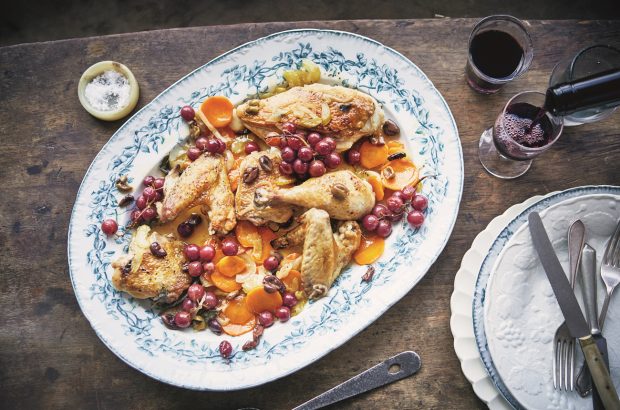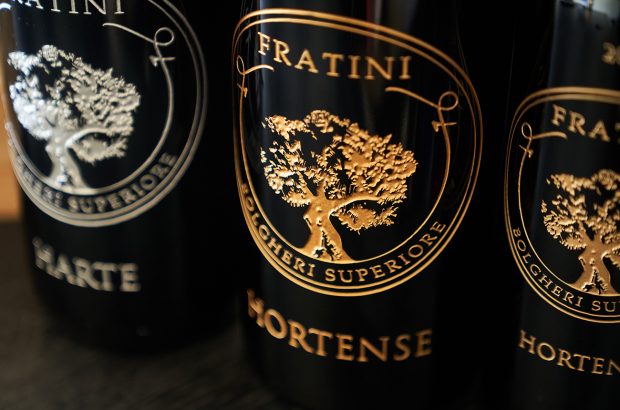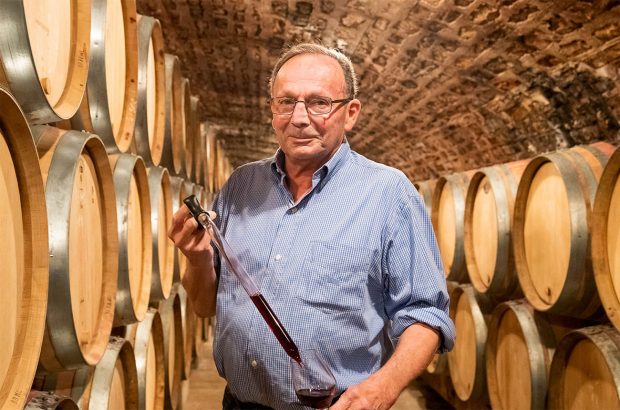When we arrived at Copower Jade winery, first stop of our Ningxia visit, we were only in time to see local farmers picking the last batch of Petit Mangseng for their late-harvest sweet wine. Most vines, in early November, are already buried under the yellow earth. They will hibernate until the next spring.
Helan mountain stood quietly afar wearing a snowy cap, overlooking the Loess Plateau under the sandstorm-stained winter sky – exactly as I remembered it two years ago. But everything else is changing fast in this up-and-coming fine wine region in China…
Ningxia geology: Things you may not know
The wine planting area occupies the north tip of the Ningxia Autonomous Region, northwest China. Most of its vineyards are found in a narrow strip of land stretching 150km north to south. Viticulture became possible thanks to the Helan Mountain range to the west that provides shelter, and the Yellow River to the east, which serves as a water source. The region is generally steeper, more mountainous on the north and flatter on the south. Alluvial sand and gravel (rock) occupy the lands closer to the mountain, and clay on the plain.

Vines waiting to be buried at Chateau Changyu Moser XV, with Helan Mountain as the backdrop.
Ningxia has a reputation for its plentiful sunshine – over 3100 hours of sunshine and over 200 frost-free days per year, according to statistics from the Ningxia wine bureau – or the ‘Administrative Committee of the Grape Industry Zone of Helan Mountain East Foothills’.
The climate is extremely continental – short and hot summers are moderated by high altitude (with some vineyards sit 1200m above sea level) and cool nights, which help to slow down the ripening process and retain acidity. Winter in Ningxia is long and harsh, producers need to bury their vines early November then dig them out in March next year, adding extra costs to the production.
‘Vine burying takes up to 30% of our annual costs in vineyard management,’ said Zhang Jing of Helan Qingxue vineyard. It takes 150 people to do 35 hectares in 1.5 weeks, we were told.
Ningxia is arid, with only 200mm annual rainfall. Irrigation via the Yellow River is a must; though the advanced Israeli drip irrigation systems installed in those shiny new estates are the most talked about, flood irrigation is also common here.
There is however a limit to how much water the region can take from China’s ‘Mother River’, as provinces downstream also rely on its supply, said Chinese wine authority Professor Li Demei.
In order to reduce the expenses on water supply, many producers dig wells and build reservoirs. Also in order to fulfil environmental protection requirements from the central government, there is an increasing number of producers, including Chateau Miqin, Helan Qingxue and Kanaan, investing into wastewater treatment and recycling facilities, according to Ningxia wine bureau.

White salt crusts are visible on the bare, loess-covered vineyards of Ningxia.
Like the driest regions in Australia and Argentina, the soil in Ningxia is low in organic matter but high in pH and salinity, said Professor Li, pointing at the white salt crusts visible on the bare, loess-covered vineyards.
It’s worth noting that Ningxia is not entirely free from fungal diseases, as most rainfall come late summer. The deeply inland region is also feeling the influence of global climate change, said Professor Li; its average annual temperature has already raised by more than one degree from 1988 to 2017, while annual rainfall is also rising in the last decade.
From north to south, there are now six defined subregions; Shizuishan, Helan, Yinchuan, Yongning, Qingtongxia and Hongsipu. You can find some of the best-known boutique producers such as Silver Heights, Helan Qingxue and Kannan in Yinchuan subregion, which sits closest to the regional capital. Some of the big international players such as Domaine Chandon (LVMH), Helan Mountain (Pernod Ricard) are in Yongning, south of Yinchuan subregion.
Interestingly, regions at higher altitude and more northernly location don’t necessarily enjoy cooler temperature, said the renowned consultant who has multiple projects across the region. As the height of Helan Mountain decreases towards south, chilling westerly wind from the Gobi Desert is allowed in, hitting the more southernly subregions and bringing down the temperature.
However, Professor Li was quick to add that vineyard and cellar management, rather than regionality and terroir, is more important in shaping the style of Ningxia wines.
Wine tourism
Latest figures from the local wine body shows that by the end of 2016, the region has 40,000 ha of vineyards and 86 completed wine estates, producing 120 million bottles of wine each year, creating 120,000 jobs.
Part of those jobs are devoted in tourism, as the wine region currently receives over 400,000 visitors each year, according to the local wine body.
One hour’s drive away from the Yinchuan city centre, Zhihui Yuanshi winery received 150,000 visitors last year, according to the owner Yuan Yuan.
Some of them are merchants, but nearly 60% are tourists from Yinchuan, who arrive via buses at this picturesque winery for tours and tastings, said chief winemaker Yang Weiming. These visitors may not know much about wine, but they do know wine has now become a specialty of Ningxia – or the ‘oasis of the Gobi Desert’.
‘Tourist purchase accounts for 30% of our sales,’ said Yuan, whose winery currently produce 200,000 bottles per year. The most popular programme, she said, is a 30 CNY (3.3 GBP) per person tasting session of three fruit-driven wines, including a dry white, a dry red and a rosé.

Tasting room at Chateau Yuanshi, Ningxia
In order to receive consistent flow of visitors, ‘your winery needs to have some unique features, and something the visitors can take part in, and stay for longer,’ said Yuan, ‘after the immersive experience, they are likely to make a purchase.’
She does have a rather special estate – as its name ‘Yuanshi (from the mountains)’ suggests, the entire estate was built on the ruins of a gravel mine and decorated with stones found locally. Besides its 133 ha vines, the winery includes a Tibetan palace-shaped chateau, an underground cellar, a restaurant, and a spacious, gracefully decorated tasting room.
In fact, having the capacity to receive tourists is one of the key criteria for Ningxia wineries to enter the five-tier classification system launched in 2013. Zhihui Yuanshi is one of the three ‘third growths’ in the 2017 edition of the classification. It is also a likely candidate to be upgraded to ‘second growths’ in the 2019 review.
Click here to view the full 2017 classification listing>>
Chateau Changyu Moser XV, backed by China’s oldest and biggest wine producing company Changyu, is another estate built with tourism in its mind.

Chateau Changyu Moser XV, Ningxia
With a total investment of 600m CNY (65m GBP), Chateau Changyu Moser XV opened to the public in 2013, one year earlier than Yuanshi. The estate’s central piece is a ‘Byzantine-style’ chateau (see above).
The chateau, which can be mistaken for one in Bordeaux, is also a popular movie set, we were told, and I do remember from two years ago seeing a hospital-like set and a couple of rusted cages on our way to the cellar.
‘We receive 50,000 – 80,000 visitors each year,’ said Fan Xi, chief engineer (winemaker) and deputy general manager of the estate, ‘70% of them are consumers who do not work in wine.’
Different from Yuanshi, visitors only purchase 1% of the estate’s astonishing 1500 tonnes of annual production, most of which is pumped into the Changyu group’s wide-spread distribution channels around China and abroad, said the winemaker.
Related article: Five things to know about China’s Chateau Changyu Moser XV
Each visitor, however, pays 80 CNY (8.7 GBP) per ticket for a tour in the massive built-in wine museum, where they get to see every element of winemaking, experience wine aromas, and learn about the century-long history of Changyu, which also coincides the winemaking heritage of China. They can even make their own labelled wines at an extra cost.
‘For us wine tours are more important for branding and nurturing potential customers; sales come second,’ said Fan. ‘At the end of the tour, we want our visitors to feel that they have gained some knowledge about wine.’
‘There’s a huge potential in education here,’ said British wine critic Robert Joseph, who is also at our press tour, ‘every year thousands of consumers are exposed to wine via these visits. It’s likely some of them will become regular wine drinkers in the future.’
Affordable Ningxia wines
Since Helan Qingxue Winery’s win of an International Trophy (equivalent to Best in Show) at Decanter World Wine Awards in 2011, Ningxia has been the leading Chinese region to win medals from Decanter Awards. From the 2019 awards, 60 Ningxia wines have won a Bronze Medal and above in Decanter World Wine Awards (DWWA) and 45 in Decanter Asia Wine Awards (DAWA).
But the fine wines from Ningxia are not easily affordable. The grand wine of Changyu Moser XV is sold at 1500 CNY (£165) per bottle at cellar door, Yuanshi Vineyard’s top cuvee ‘Soul of Mountain’ charges 980 CNY (£107) per bottle, while Helan Qingxue’s Jiabeilan Reserve is at 498 CNY (£54) mark.
The high prices are partially due to the labour-intensive production process (especially vine burying), but also derive from the need of branding, said the producers.
Though the most famous producers don’t worry much about sales, for a young wine region expanding in such nerve-racking speed, how to start selling wines in considerable and steady volume outside Ningxia has become a burning question, as several trade professionals disclosed unanimously during our trip.
Clearly, the Ningxia wine bureau is ready to step in; and the sheer scale of the region, they seem to believe, is the answer.
As the first step of the government-initiated sales drive, several producers were joint together under the umbrella of a new, regional brand – Helan Hong (贺兰红).

The new regional brand ‘Ningxia Hong’ (right) featured at Ningxia Wine Bureau media tasting.
Hong means ‘red’ in Chinese, a colour culturally associated with grape wine in China, though its portfolio also includes white wines. Key variety used include Cabernet Sauvignon for red and Italian Riesling for white, and the grapes can be sourced from any of the six designated producers.
The brand was launched at Ningxia Autonomous Region’s 60-year anniversary in September 2018 – a clear endorsement in itself – with the ambition to create Ningxia’s own ‘super best seller’ with quality and volume, and most importantly, more affordable price.
On the official store of Ningxia wine region on JD.com, the entry level Helan Hong Cabernet Sauvignon is sold at 128 CNY (£14) per bottle, a price point deemed much more competitive facing the impact of imported wines in Mainland China.
‘The initial feedback from the market (of Helan Hong) has been positive,’ stated the wine bureau, adding that more ambitious projects are on the way. In September 2019, the government is investing 700 million CNY to build a ‘shared winery’ and have rounded up a total of 100,000mu (6667 ha) of vineyards, partially from existing wineries, dedicated to the production of Helan Hong.
Meanwhile, the region is now seriously seeking to expand overseas; in June 2019, 50,000 bottles of ‘Helan Hong’ arrived in Belgium via the X8011 Sino-Euro railway, with a further 250,000 bottles making their ways to Germany.
These wines carry labels tailor-made for the EU, with an initial retail price at 25 Euros per bottle. They are set to appear in major European supermarkets including Carrefour and ‘at least 30’ boutique restaurants, according to the regional body (nxputao.org.cn).
The new leads
Xige Estate, which opened to the public on 16th May 2019 as the 87th wine estate in Ningxia, is one of the six current designated producers of Helan Hong.
With a dazzling 400 million CNY investment, Xige – which literally means ‘dove from the west’ – completed the construction of its grandeur estate at the Pigeon Hill foothills in just two years (2015 to 2017).
The fortress-like estate covers 25000 square metres of land, containing some of the world’s most advanced winemaking equipment, with a capacity to make 10,000 tonnes of wine each year, said the chief winemaker Liao Zusong, as we stood on the viewing platform gazing down to the 2000 oak barrels under spotlights.

Xige Estate has 2000 oak barrels in its cellar.
But Helan Hong is not what Xige is all about. ‘We decided to launch this project because we have considerable plantings of vines over 20 years old, which is very rare in Ningxia,’ said the owner Zhang Yanzhi. The Bordeaux-trained oenologist was referring to the 1000 hectares of vines over 22 years old, located in the Qingtongxia sub-region, south of Ningxia.
Very rare indeed – considering much of the Ningxia’s gigantic wine planting project started less than ten years ago. Zhang’s team, however, has the luxury of using these old vines to make the ‘Jade Dove Single Vineyard’ range. The Cabernet Gernischt (Carménère) 2017 was my highlight from the range; still carrying the variety’s tell-tale (and sometimes frowned-upon) green pepper notes, it was one of the most perfumed and ripest expressions of the variety that I have tasted.
But the most intriguing wines of the evening came at the end of the dinner, when the youngwinemaker sneaked a few journalists into his cellar. We tasted from the barrel the estate’s yet-to-be-released wines, including a Sauvignon Blanc, and a stunningly fresh and elegant Pinot Noir.
As we flew out from the oasis on the edge of Gobi Desert, I tried to type down my new discoveries from the trip since my last visit. Soon I realised that perhaps I need to come back sooner than another two years later.
Tasting what’s new in Ningxia















